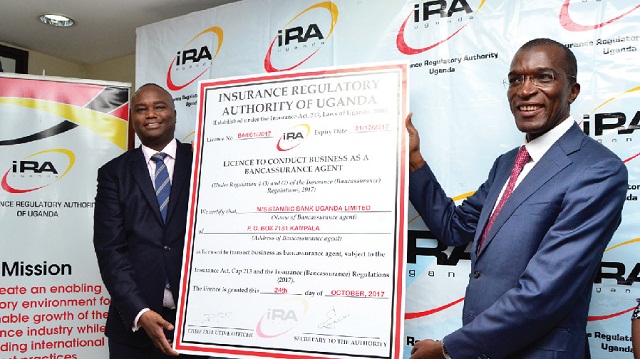
New move expected to boost country’s insurance penetration
Kampala, Uganda | ISAAC KHISA | For a long time, buying insurance policies in Uganda through commercial banks, also known as bancassurance, remained unthinkable.
Policies were purchased directly from insurers’ branches or through brokers, a situation that had been blamed for a slowdown in the uptake of insurance services.
But things have changed over the past three months since President Yoweri Museveni signed into law the Financial Institutions Amendment Act 2016, allowing commercial banks to venture into insurance; kicking off a scramble for a pie of the country’s insurance business.
So far, six out of the country’s 24 commercial banks have been granted licences from the Insurance Regulatory Authority of Uganda (IRA-U) to sell insurance products through their branches in partnership with the 29 insurers.
Diamond Trust Bank, the latest entrant, joins Bank of Africa, Barclays Bank, Finance Trust Bank, NC Bank and Stanbic Bank.
Meanwhile, Centenary and Orient Bank have advertised positions for the bancassurance managers, signalling their intention to venture into the insurance once granted licence.
The banks will earn 20% as commission on premium paid for each insurance policy sold, as they strive to flog as many products as possible to their customers in order to cover the high fixed costs of maintaining their outlets.
This development comes in as many months since IRA-U unveiled regulations to guide banks in the sale of insurance products in July last year.
It also coincides with the economy showing signs of recovery compared with the previous year even as the government plans to invest US$3.55bn and US$4bn in oil pipeline and refinery, receptively, ahead of oil production in 2020.
Varghese Thambi, the managing director at Diamond Trust Bank Uganda said the new development in the insurance industry will speed up penetration (all the money spent on buying insurance equivalent to the economy) , which has stagnated at less than 1% – the lowest in the East African region.
Kenya’s insurance penetration stands at 3.4%, 2.3% in Tanzania, and Rwanda 1%. The average penetration for Africa is 6%.
“It is 99% an opportunity for us since the insurance penetration is still very low,” he said, “There is less number of outlets in the insurance sector and we have opened up windows through our 38 branches.”
Thambi said the bank will carry out free training on the importance of insurance to its customers from their respective branches.
Statistics from Bank of Uganda show that there are 570 bank branches and 860 ATM’s in the country as at the end of 2016.
Patrick Mweheire, the Chief Executive at Stanbic Bank, said “we have been preparing to launch the service for some time now and have invested significantly in training staff, signing partnerships and putting in place the technology and infrastructure needed to roll out the product smoothly.”
He, however, said the success of this new product will involve raising public knowledge and awareness about the various benefits and types of insurance products available through banks.
“To that end, we look forward to working with the regulator and other industry players to run effective communications and stakeholder initiatives that will ensure this happens,” he said while receiving the bancassurance licence on behalf of the lender.
“Because everything happens under one roof, bancassurance will provide customers with a one-stop-shop solution which offers greater convenience, savings and choice,” said Lydia Kayonde, head of bancassurance at Stanbic Bank.
She added that premium prices will also be better negotiated, improve product turnaround times and lower costs to serve customers compared with traditional sales channels.
Bancassurance in other parts of the world
This comes at the time when distribution of insurance products through banks is gradually becoming widespread in many other parts of the world, according to Ibrahim Kaddunabbi Lubega, the Chief Executive Officer at IRA-U.
“In Africa, for example, South Africa, Botswana, Ghana, Zambia, Zimbabwe, Kenya among others, Banks are already utilizing this distribution channel,” he said.
Globally, the natural home of bancassurance, the combination of banking and insurance, is in countries such as Spain, Brazil and France, where people are culturally accustomed to buying insurance from banks.
In Spain, about 75% of life-insurance products are purchased through bank branches, according to Ernst and Young, and France and Brazil accounts for 64%.
In China, Germany and Mexico about 39%, 24% and 22% respectively of the life-insurance products are purchased through bank branches compared with 10% in USA.
Kaddunabbi believes that bancassurance will provide an ideal niche or focused market for the insurance products given the presence of a significant number of financially sound commercial banks in Uganda with a countrywide network of branches, a large client base, customer goodwill, product innovation capabilities and an enabling technological platform.
 The Independent Uganda: You get the Truth we Pay the Price
The Independent Uganda: You get the Truth we Pay the Price





